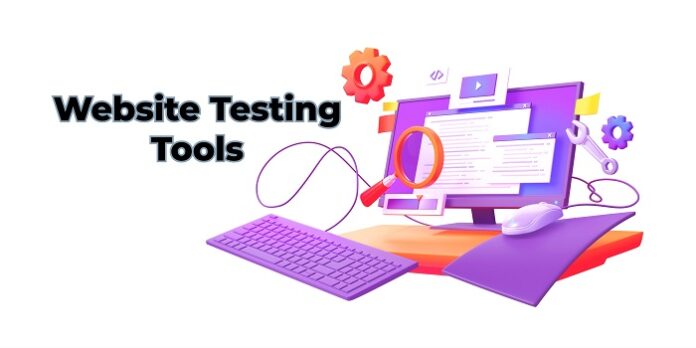A website includes architecture, UI/UX design, security procedures, and a collection of technologies. Checking these helps to ensure that the website is working adequately. Automation testing is a crucial step in any website application development process. It guarantees a website’s functionality, security, dependability, and during development. Additionally, web testing is critical to delivering users an error-free and flawless online application.
Nevertheless, it can be overwhelming if you do not have the right expertise and tools. Many websites still launch with errors that negatively affect their overall success. Fixing a website failure after launch costs time and money. To minimize these risks and keep the web quality high, thorough testing is essential. Website testing is not what it used to be before. The website or web application must work flawlessly on desktop browsers and mobile devices.
Testing the website is an effective way to guarantee that it yields all quality standards. For this, the best website testing tool is mandated. As the world around us becomes automated, so do the testing tools. The worldwide auto testing market is expected to rise with an aggregate of 14.3% annual growth (compounded) and be estimated at US$ 93.6 billion by the closing of 2032. To ensure website quality, one must examine their website on end-user experience level, functionality, user interface, and more.
This article will explore the best website testing tools for 2024.
What is Website Testing?
A website application is a program spread through the Internet in the browser interface form. A web application’s purpose is to exchange information with users in an effective way while working with a variety of operating systems and browsers.
Website testing is a software testing process that helps ensure the application’s quality and functionality meet the requirements. Before delivery, website testing must pinpoint all underlying issues, including functional inconsistencies, integration issues, environmental challenges, traffic stress, or security breaches.
The numerous testing techniques entangled in the web application are:
Website Interface Testing: Interface testing is conducted to assess the interoperability of the web interface with different servers and to evaluate its response to simulated interruptions. The web server, database server, and application server are three vital areas to concentrate on.
Website Functionality Testing: Functional testing is a critical process that evaluates whether the initial build functions according to its intended specifications. It includes database connection checking, HTML and CSS validation, cookie testing, form validation, and link testing.
Website Performance Testing: For web applications, performance testing is load testing. Stress tests and scalability tests are essential for assessing a website’s performance, particularly when anticipating high levels of user traffic. Both types of testing are critical in ensuring the site can effectively accommodate a significant audience.
Website Compatibility Testing: Compatibility testing evaluates whether the website’s design suits diverse browsers and mobile devices. It includes testing for mobile browsing, OS compatibility, cross-browser compatibility, and printing options.
Benefits of Website Testing
Online presence alone is no longer sufficient. A successful website or web application launch requires website testing services.
Here are a few significance of thoroughly testing the website:
- Boosts performance speed
- Intensive testing without interruptions
- Cross-browser testing eradicates compatibility issues
- Verify all test cases for the web application function
- Assurance of functionality
- Discover any broken links on your website
- Maintains user load
- Testing the GUI enhances the user experience
- User-friendly interface
- A high-quality website is the end product
- Usability checks
- Performs security testing
How to efficiently test a Website?
An organization must develop an informative, user-friendly, and easily accessible website. The website needs to be thoroughly tested to accomplish this. Here are some points that need to be addressed while testing a website:
- Include exploratory testing in the development software process.
- Test third party and extension of the online application.
- Involve the development team throughout the testing process.
- Run performance testing in various scenarios.
- Define and pick essential criteria for usability testing.
- Keep URL strings unalterable in security tests.
- Ensure load tests are operating progressively.
- Perform rigorous testing for cross-browser compatibility.
Website testing tools help developers find bugs early and ensure the website works properly. Therefore, any organization that desires to keep a bug-free website must choose the right tool.
What Are Website Testing Tools?
Website testing tools are software applications that help assess the website’s functionality, UI, security, performance, etc., across different browsers, platforms, and devices. They help detect and resolve bugs in the early stages of development before the website enters the production stage or is made available for end-users.
Website testing tools help automate time-consuming and repetitive tasks, thereby helping save efforts, costs, resources, and time required for testing. Integrating website testing with defect-tracking tools is a valuable practice in the software development lifecycle. This helps facilitate the bug tracking and fixing procedure, improving collaboration among development and quality assurance teams.
Best Website Testing Tools For 2024
With the advancement of new technologies, developers must keep up with emerging technologies and trends. Modern website testing tools are software helpers, making it more leisurely for developers and testers to check if their websites work accurately. These tools have numerous features, like running tests, creating test cases automatically, and analyzing outcomes. They also allow developers to create scripts interacting with the website like a real user. The website testing tools make it easy to spot and resolve problems before they become significant in the website’s final version.
Here are the best website testing tools for 2024:
LambdaTest
LambdaTest stands out as a cutting-edge test orchestration and execution platform, enabling the seamless execution of manual and automated tests on a grand scale. With its expansive capabilities, you can delve into both real-time and automated testing across an extensive spectrum of over 3000 environments and authentic mobile devices, elevating your testing experience to unprecedented heights.
It is a widespread and easy-to-use cloud-based website application testing tool offering numerous cross-platform and cross-browser combinations. The tool is a test orchestration and execution platform leveraging AI technology. It enables users to conduct manual and automated tests efficiently at a large scale, encompassing over 3000 real devices, browsers, and operating system combinations.
It supports various automation testing frameworks, including Cypress, Selenium, Puppeteer, Playwright, etc., facilitating teams to execute automation tests at scale, hence expanding the test coverage. Furthermore, LambdaTest can execute tests on Chrome, Firefox, Brave, Edge, Opera, Safari, Internet Explorer, Yandex, and others while running on iOS, macOS, Android, and Windows. It supports testing OTT applications on Roku TV, Apple TV, and Amazon Fire TV.
Here are a few features of the LambdaTest:
- Run automation scripts on more than 3000 mobile and desktop devices.
- Live interactive web application testing on more than 3000 environments.
- Achieve speedy test execution with HyperExecute.
- Geolocation and localization testing across fifty-plus countries.
- Increase device coverage with real device website testing.
- Evaluating web pages hosted locally is a valuable tool for developers to conduct testing within development environments.
- Helps identify and rectify issues before deployment, thereby minimizing the occurrence of post-deployment bugs and enhancing the overall quality of the website or application.
Selenium
Selenium is the most extensively utilized and open-source automated web testing solution. It supports diverse operating systems, including Windows, Linux, and Mac, and popular browsers, including Chrome, IE, Firefox, and Headless Browsers.
Employing both desktop and mobile environments, our innovative tool seamlessly melds with applications via browsers, empowering developers and testers to execute JavaScript code effortlessly. This streamlines the testing of dynamic DOM elements, offering unparalleled efficiency. Supporting a diverse array of programming languages such as Python, C#, Java, and Ruby, our solution caters to developers fluent in any coding dialect, fostering harmonious implementation across diverse development teams.
A few pivotal features of the Selenium tool are that it:
- Consistency across various browsers.
- Supports plugins and extensions for improved functionality.
- Integrates into continuous integration and continuous deployment pipelines.
- Integrates with popular testing frameworks, such as TestNG and JUnit.
- Speeds up testing by executing multiple tests simultaneously.
Appium
Appium is an open-source, cloud-based automated tool for testing web and mobile applications. The cloud-based tool authorizes cross-platform application testing and supports diverse programming languages. Furthermore, Appium scripts can be written in Python, Ruby, Java, JS, and other languages.
Appium offers a suite of tools that uniformly facilitate this type of automation on multiple platforms. Additionally, Appium is a platform-specific tool that requires toolchains, specialized knowledge, and specific programming language experience. With its stable interface that is compatible with widely used programming languages, Appium strives to combine all these automation technologies under one roof.
A few pivotal features of Appium are that it:
- Provide platform-specific automation features through a standard, cross-platform API.
- Supports programming languages, including C#, Python, PHP, JavaScript, Java, Ruby, and Perl.
- Utilizes the reusable test scripts and APIs for cross-platform testing.
- Integrations with CI/CD tools and testing frameworks
- Give resources to the community to efficiently develop Appium extensions.
Cypress
Cypress, an automated testing tool, is an open-source project. The tool is renowned for its extensive documentation and includes libraries. Cypress is mainly concerned with end-to-end testing, especially for applications that use contemporary JavaScript frameworks.
Cypress is useful for applications created with modern JavaScript frameworks like React, Angular, and Vue. Additionally, the tool can perform its magic with programs rendered on servers. With glaringly development and execution with quick tests, features such as shadow DOM and DOM modification may be used to create robust end-to-end testing scenarios.
A few pivotal features of Cypress are:
- Enables easy debugging with reviewing test execution and rewinding.
- Offers instant feedback on code modifications during test development.
- Provides a comprehensive framework for entire application testing.
- Captures the test state and delivers video recording for analysis.
- Authorizes simultaneous test execution, optimizing test workflows.
- User-friendly commands for seamless application interaction.
Conclusion
Website testing is crucial for ensuring a successful and efficient online presence. With the ever-evolving technology and user expectations, utilizing the best website testing tools is essential for staying ahead of the competition. By investing in these tools, businesses can identify and fix issues, improve user experience, and ultimately achieve their goals. With the right website testing tools, organizations can elevate their online presence and drive growth in the rapidly changing digital landscape.





